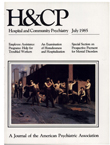Employee Assistance Programs: An Overview and Suggested Roles for Psychiatrists
Abstract
Although employee assistance programs are rapidly becoming the predominant vehicle for the delivery of mental health services in occupational settings, few programs employ a psychiatrist on either a part-time or a full-time basis. After providing an overview of the need. for, cost-effectiveness of, and current status of employee assistance programs, the authors draw on their own experiences with employee assistance programs to present four broad categories of roles the psychiatrist can assume in such programs: clinician, supervisor and educator, administrator, and organizational consultant. Problems encountered in these roles are also discussed.
Access content
To read the fulltext, please use one of the options below to sign in or purchase access.- Personal login
- Institutional Login
- Sign in via OpenAthens
- Register for access
-
Please login/register if you wish to pair your device and check access availability.
Not a subscriber?
PsychiatryOnline subscription options offer access to the DSM-5 library, books, journals, CME, and patient resources. This all-in-one virtual library provides psychiatrists and mental health professionals with key resources for diagnosis, treatment, research, and professional development.
Need more help? PsychiatryOnline Customer Service may be reached by emailing [email protected] or by calling 800-368-5777 (in the U.S.) or 703-907-7322 (outside the U.S.).



